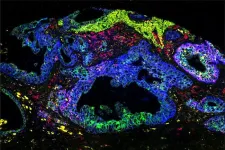(Press-News.org) Nanoporous membranes with atomic-scale holes smaller than one-billionth of a meter have powerful potential for decontaminating polluted water, pulling valuable metal ions from the water, or for osmotic power generators.
But these exciting applications have been limited in part by the tedious process of tunneling individual sub-nanometer pores one by one.
“If we are to ever scale up 2D material membranes to be relevant for applications outside the laboratory, the ‘one pore at a time’ method just isn't feasible,” said recent UChicago Pritzker School of Molecular Engineering (PME) PhD graduate Eli Hoenig. “But, even within the confines of laboratory experiment, a nanoporous membrane provides significantly larger signals than a single pore, increasing the sensitivity.”
Hoenig is first author of a paper recently published in Nature Communications that found a novel path around this longstanding problem. Under PME Asst. Prof. Chong Liu, the team created a new method of pore generation that builds materials with intentional weak spots, then applies a remote electric field to generate multiple nanoscale pores all at once.
“Our logic is that, if we can pre-design what the material looks like and design where the weak points are, then when we do the pore generation, the field will pick up those weaker points and start to drill holes there first,” Liu said.
The strength of weakness
By overlapping a few layers of polycrystalline molybdenum disulfide, the team can control where the crystals met.
“Say I have two perfect crystals. When the two crystals come together, they will not be smoothly just glued together. There's an interface where they start to connect to each other,” Liu said. “That’s called the grain boundary.”
This means they can “pre-pattern” the grain boundaries—and the pores that will eventually form there—with a remarkable level of control.
But it isn’t just location that can be fine-tuned through this technique. The concentration of the pores and even their sizes can be determined in advance. The team was able to tune the size of the pore from 4 nanometers to smaller than 1 nanometer.
This allows flexibility for engineering water treatment systems, fuel cells or any number of other applications.
“People want to precisely create and confine pores, but usually the method is limited so that you can only create one pore at a time,” Liu said. “And so that's why we developed a method to create high-density pores where you are still able to control the precision and size of each individual pore.”
While the technique has a number of uses, Hoenig finds the environmental applications most exciting. These include treating water and extracting valuable materials such as the lithium needed for the grid-scale batteries demanded by the world’s transition to renewable energy.
“Targeted water decontamination and resource recovery are, at least at this basic science level, two sides of the same coin, and both, to me, are really important,” Hoenig said.
Liu said this new paper is an intellectual offshoot of an interdisciplinary collaboration with the battery-focused laboratory of PME Prof. Shirley Meng and PME Asst. Prof. Shuolong Yang’s quantum group. Working across academic silos, the three labs previously collaborated to break through a longstanding hurdle in growing quantum qubits on crystals.
“Our three teams are trying to develop precision synthesis techniques, not only for one type of material and not only for one type of material property,” Liu said. “Together, we are looking at how we can manipulate a material’s composition, structure, and defects to be able to create precise defects and pores.”
Citation: “In situ generation of (sub) nanometer pores in MoS2 membranes for ion-selective transport” Hoenig et al. Nature Communications. Sept. 10, 2024. DOI: https://doi.org/10.1038/s41467-024-52109-8
END
Beyond ‘one pore at a time’
A new method of generating multiple, tunable nanopores could revolutionize membrane technology
2024-10-02
ELSE PRESS RELEASES FROM THIS DATE:
New study explores how universities can improve student well-being
2024-10-02
Historically, a university’s primary role has been to ensure students excel academically, but higher education can also change lives by supporting their well-being. Despite growing evidence of the importance of student well-being and an abundance of best practices, most institutions have yet to prioritize it as much as they do enrollment, graduation and grades.
A new study led by University of Maine researchers provides guidance on how institutions can support and enhance student well-being, and breaks down the various benefits for learners during and beyond their university career. It was published in PNAS Nexus, the ...
Community-based programs in senior centers may lower health care use and costs for people with dementia
2024-10-02
Living with dementia in communities with senior centers providing access to adult day health and social services was associated with fewer hospitalizations and lower health care use and Medicare costs, according to researchers from Rutgers University-New Brunswick and the University of Massachusetts Boston.
The results, published in Heath Affairs Scholar, underscore the potential of senior centers in minimizing health care costs and acute care usage among those with dementia, particularly in smaller communities where centers provide access to such services.
“Our findings provide evidence to support ...
Q&A: UW researchers examine link between light pollution and interest in astronomy
2024-10-02
Picture walking outside on a dark, cloudless evening. You look up to admire the stars — maybe even a planet, if you’re lucky — and a sense of wonder washes of you. New research from the University of Washington shows this might be more than a memorable experience: It could ultimately spark scientific curiosity and influence life choices.
Rodolfo Cortes Barragan, research scientist the UW Institute for Learning and Brain Sciences (I-LABS), and Andrew Meltzoff, co-director of I-LABS and professor of psychology, recently co-authored a study in Nature Scientific Reports showing a link between the ability to see the stars ...
PCORI awards $37 million to accelerate implementation of evidence-based health research
2024-10-02
WASHINGTON, D.C., Oct. 2, 2024 — The Patient-Centered Outcomes Research Institute (PCORI) today announced $37 million in funding awards through its Health Systems Implementation Initiative (HSII). These awards will support 25 projects implementing PCORI-funded comparative clinical effectiveness research (CER) findings in participating HSII health systems.
Key Points:
Twenty-five HSII participant health systems, covering more than 2,300 care sites across the country, received PCORI funding awards.
HSII implementation projects will focus on one of two main areas:
Improving antibiotic ...
Researchers develop insights into KRAS mutations in pancreatic cancers
2024-10-02
A common mutation in the KRAS gene is associated with improved overall survival in pancreatic ductal adenocarcinoma (PDAC) compared with other variants, in part because the mutation appears to lead to less invasiveness and weaker biological activity, according to a multicenter study conducted at Weill Cornell Medicine, NewYork-Presbyterian, Memorial Sloan Kettering Cancer Center, and other institutions.
The research, published August 29 in Cancer Cell, demonstrates that KRAS mutations, which occur in about 95 percent of people who ...
New CAMH-led study highlights effective treatment for male postpartum depression
2024-10-02
(Toronto, Canada) – A new study from the Centre for Addiction and Mental Health (CAMH), in collaboration with leading researchers in Pakistan, has demonstrated the effectiveness of an integrated psychosocial intervention aimed at improving parenting skills and symptoms of depression. The treatment was effective for male postpartum depression (PPD) in a cohort of Pakistani fathers, improving both paternal mental health and child development outcomes.
“Male mental health, and especially postpartum depression in fathers, remains a stigmatized and understudied area,” says Dr. Ishrat Husain, the study's lead investigator and senior ...
Global study highlights the life-saving impact of Guideline-Directed Medical Therapy (GDMT) in heart failure patients
2024-10-02
Heart failure is a rapidly growing public health issue that can be difficult to manage on a global scale. But there are tools that exist that can improve outcomes, such as guideline-directed medical therapy (GDMT). New UCLA-led research highlights the important role that these guidelines can play in reducing mortality rates for individuals suffering from heart failure with reduced ejection fraction (HFrEF), a type of heart failure affecting an estimated 29 million people worldwide.
“These guidelines are being significantly underutilized in clinical settings globally and there ...
New method quantifies single-cell data’s risk of private information leakage
2024-10-02
Access to publicly available human single-cell gene expression datasets, or scRNA-seq datasets, has significantly enhanced researchers’ understanding of both complex biological systems and the etymology of various diseases. However, the increase in accessibility raises a greater concern about the privacy of the individuals who donated the cells and the likelihood of their private health details being shared without consent.
Previous studies on these privacy breaches have focused on bulk gene expression data sharing, where the average expression levels of genes are measured across a large population of cells from a tissue or sample rather than an individual cell. Because single-cell ...
Eyes on the fries: how our vision creates a food trend
2024-10-02
KEY POINTS
Human judgement of food images is influenced by judgements that precede it
Experiment tested reactions of more than 600 people making food choices
Highly relevant given widespread use of Uber Eats or phone-based menus
Finding could assist treatments for eating disorders or assist with food marketing
Research at the University of Sydney has revealed that we don’t judge food simply on its merits but are influenced by what we have seen beforehand, a cascading phenomenon known as ‘serial dependence’.
The research, published today in the high-impact journal Current Biology, was conducted by Professors David Alais ...
UVM scientist maps fruit fly brain
2024-10-02
A team of scientists supported by the National Institutes of Health (NIH)’s The BRAIN Initiative®, including Davi Bock, Ph.D., Associate Professor of Neurological Sciences at UVM’s Robert Larner, M.D. College of Medicine, recently made a substantial advancement in neurobiological research by successfully mapping the entire brain of Drosophila melanogaster, more commonly known as the fruit fly.
The study, titled “Whole-brain annotation and multi-connectome cell typing of Drosophila,” recently published ...
LAST 30 PRESS RELEASES:
Strengthened immune defense against cancer
Engineering the development of the pancreas
The Journal of Nuclear Medicine ahead-of-print tip sheet: Jan. 9, 2026
Mount Sinai researchers help create largest immune cell atlas of bone marrow in multiple myeloma patients
Why it is so hard to get started on an unpleasant task: Scientists identify a “motivation brake”
Body composition changes after bariatric surgery or treatment with GLP-1 receptor agonists
Targeted regulation of abortion providers laws and pregnancies conceived through fertility treatment
Press registration is now open for the 2026 ACMG Annual Clinical Genetics Meeting
Understanding sex-based differences and the role of bone morphogenetic protein signaling in Alzheimer’s disease
Breakthrough in thin-film electrolytes pushes solid oxide fuel cells forward
Clues from the past reveal the West Antarctic Ice Sheet’s vulnerability to warming
Collaborative study uncovers unknown causes of blindness
Inflammatory immune cells predict survival, relapse in multiple myeloma
New test shows which antibiotics actually work
Most Alzheimer’s cases linked to variants in a single gene
Finding the genome's blind spot
The secret room a giant virus creates inside its host amoeba
World’s vast plant knowledge not being fully exploited to tackle biodiversity and climate challenges, warn researchers
New study explains the link between long-term diabetes and vascular damage
Ocean temperatures reached another record high in 2025
Dynamically reconfigurable topological routing in nonlinear photonic systems
Crystallographic engineering enables fast low‑temperature ion transport of TiNb2O7 for cold‑region lithium‑ion batteries
Ultrafast sulfur redox dynamics enabled by a PPy@N‑TiO2 Z‑scheme heterojunction photoelectrode for photo‑assisted lithium–sulfur batteries
Optimized biochar use could cut China’s cropland nitrous oxide emissions by up to half
Neural progesterone receptors link ovulation and sexual receptivity in medaka
A new Japanese study investigates how tariff policies influence long-run economic growth
Mental trauma succeeds 1 in 7 dog related injuries, claims data suggest
Breastfeeding may lower mums’ later life depression/anxiety risks for up to 10 years after pregnancy
Study finds more than a quarter of adults worldwide could benefit from GLP-1 medications for weight loss
Hobbies don’t just improve personal lives, they can boost workplace creativity too
[Press-News.org] Beyond ‘one pore at a time’A new method of generating multiple, tunable nanopores could revolutionize membrane technology






